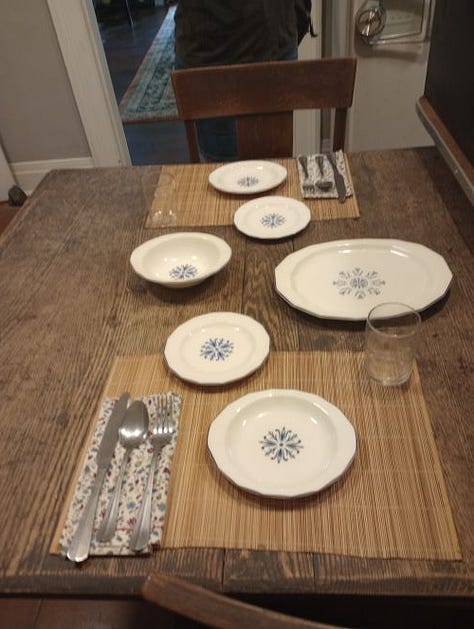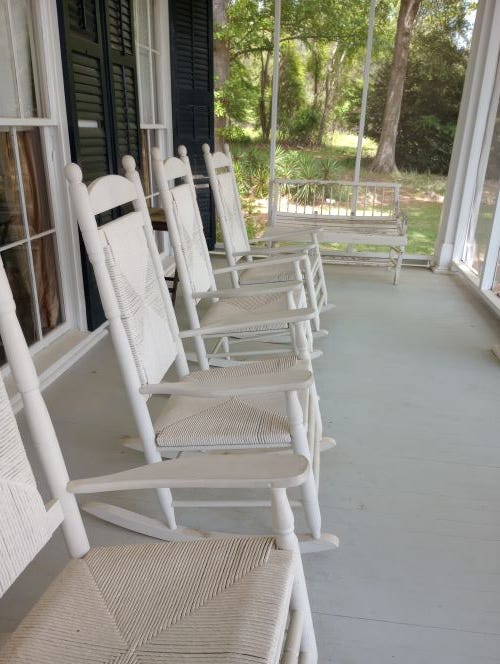an afternoon with Flannery O'Connor
a letter from Andalucia (not the one in Spain)
One of my favorite stories about Flannery O’Connor involved her going to a dinner at Mary McCarthy’s house, invited by the poet Robert Lowell and his wife Elizabeth Hardwick. Flannery spent much of the dinner feeling insufficiently sophisticated to take part in the conversation, but things took a turn when lapsed Catholic Mary McCarthy spoke of the Eucharist and said, perhaps somewhat condescendingly, that it was a nice symbol. Flannery felt that this was a pointed remark aimed specifically at her with the expectation of her rebuttal, but she could think of nothing to say but, “Well, if it’s a symbol, to hell with it!”
One of my favorite stories by Flannery O’Connor, “The Enduring Chill,” pokes apart the same kind of intellectual pretension, this time in the person of Asbury, a writer who left behind the South and all it meant to move about in urbane New York City literary circles only to find himself forced back to his mother’s farm when he discovers he is seriously ill (not terribly unlike Flannery herself). There, he goes on to comport himelf like the cosmopolitan New Yorker he feels himself to be, which includes patronizing the black farm workers, essentially using them as symbols to demonstrate his own enlightened views about race and the common man, and trying to educate his mother and sister, both of whom he views as hopelessly backwards and ignorant.
At the beginning of the story, Asbury’s mother picks him up at the train station, and Flannery is unsparing as she’s ever been in depicting the thought processes of a callow young person who believes only they are wise and jaded enough to see the world as it truly is:
She had given a little cry; she looked aghast. He was pleased that she should see death in his face at once. His mother, at the age of sixty, was going to be introduced to reality and he supposed that if the experience didn’t kill her, it would assist her in the process of growing up.
I won’t spoil the story for you, but suffice it to say that Flannery continues on in this manner, her observations about the foibiles of human being as merciless as if she’d pinned them to a card like a bug to study them.
It’s not that she is unsympathetic to her characters. Here is Asbury’s feeling, one I know all too well, as he sees the train that brought him back from New York depart:
The train glided silently away behind him, leaving a view of the twin block of dilapidated stores. It seemed to him that his last connection with a larger world was vanishing forever.
She had that quality that all great writers must possess: the ability to see into the humanity of everyone she was writing about—yes, even The Grandmother, even The Misfit1. It’s easy to write terrible characters. It’s much harder to write terrible characters who possess shades of grey, who, no matter how mad or murderous, greedy or pathetic, deluded or destructive or irritating they may be, are still human2, as even the worst among us are. This was, I think, part and parcel of her unwavering faith, a faith that I do not share, but I do aspire to the same disposition toward my fellow humans, as unfashionable as that has unfortunately become—and I don’t think my writing will ever be as good as it can be if I cannot achieve this.
Flannery O’Connor, who died from lupus at the age of thirty-nine after publishing dozens of short stories and essays as well as two novels, was a Southern Gothic writer whose work was guided by a profound moral sense and rooted in her devout Catholicism. She was a ruthless chronicler of human nature, and her work is, by turns, funny, shocking, tragic, transcendent.
I visited her childhood home in Savannah, Georgia years ago, but I’d never been to the place where she spent the last thirteen years of her life and did most of her writing, Andalucia Farm in Milledgeville, Georgia. Last month, with my friend Kelly visiting from England, I took the opportunity to drive down there, where there is a newly-opened interpretive center and work still in progress on the impressively almost thoroughly restored house and grounds. If you want to simply wander outside for free, you can do so, but it’s worth paying $7 for the tour through the house by perhaps the most charming and irrepressible docent I’ve ever had the pleasure of encountering. Her love for the life and work of Flannery O’Connor and that of everyone involved in preserving Andalucia suffuses the place.
What makes this a particularly extraordinary experience is that when Flannery’s mother Regina went to live with relatives a few years after her daughter’s death, she essentially walked out the door and left everything exactly as it was. This means that, as the guide told us, more than 90% of what you see in the house is original and in the place it was when Flannery was alive, as it was either left or as reconstructed by photos and living relatives. Flannery’s aunt even came in and redid the table settings in the kitchen!



We moved through the house and as it was a quiet weekday spring afternoon it was just the three of us, Kelly, the docent, and me, and as we were so enthusiastic the already-animated guide became even more so, sharing more and more stories. The denouement, of course, is reaching Flannery’s bedroom, which doubled as her writing space. There was her desk, inches away from her bed, with her crutches leaning up against the desk so that she could ease herself between one and the other. She followed a strict schedule of daily Mass and daily writing—three hours for the latter—and let nothing dissuade her from either.


There was something almost holy about being in her room, her writing space, which I’m sure she would consider blasphemous. My eyes welled up with tears and I was frantically trying conceal the depth of my emotion lest our guide’s assessment of us as really fun visitors suddenly turn into really weird visitors.
After the tour (or before, or instead of), you can sit on her front porch, as Kelly and I did for some time (texting people intelligent things like OMG OMG I’M SITTING ON FLANNERY O’CONNOR’S FRONT PORCH), or walk down to the pond on the property, or visit the outbuildings (is that the barn that inspired “Good Country People”?), or walk on the trails, or enjoy a picnic.


You could spend a full day there, and in fact, that’s what I plan to do at some point in the future—maybe in the autumn, when the temperatures begin to cool. I’ll bring a picnic lunch, a book or two (maybe by Flannery), and a notebook. It’s funny how close she feels in this place, as though she just stepped out of her room and will be back any moment. I can no longer get my head around the idea of death, if I ever could. I do not understand how these bright spirits I have known, human or animal—or that I have known through their writing, the films they made, their performances, the music they played—can cease to exist so suddenly and so permanently, and Flannery would say that of course they do not, they live on and on. Other people would say they do so in our memories, in the words they leave behind, but that isn’t enough for me.
One of the things I love most about Flannery’s work is that behind her unflinching realism and the often banal or grotesque3 elements, there is a sense of the numinous. If it’s a symbol, then to hell with it! I wish I had her belief in eternity. I wish I had the faith that she maintained even after she visited Lourdes in search of a cure and was not healed.
There is a light that never goes out, sang The Smiths, and I suppose it will have to do for the likes of me.
See “A Good Man is Hard to Find,” published in 1953.
I suspect she was equally ruthless in interrogating her own actions and thoughts.
She did not like the word grotesque used in relation to her own work, feeling it was something imposed by Northerners upon Southern writers writing about things that were very natural to the Southern writer—but I think that grotesque is appropriately descriptive in this case.


I enjoyed this a great deal and put it in my Lynda folder with other of your posts I find well worth rereading.
A few years back I was driving from Athens to the coast and my route took me through Milledgeville. I saw the sign for Andalusia, did a hasty u-turn and turned in to the drive. There was no one there but me and a docent that day and I, too, was startled and amazed at the way that it seemed that Flannery had just stepped out of the room. My supervisor has a friend/colleague at Milledgeville who oversees the new interpretive center so we had our annual retreat there last year. During a break we walked the grounds and explored the little cabins that were there and walked down to the lake. Her presence is still there, I think.
But my persistent memory of Flannery is that one day while home sick from school in high school, I read a book of her short stories from cover to cover and at the end of the day I wanted to walk into the sea. I think her stories are best taken in small sips, not in one giant gulp. There is a grimness to her stories that I grapple with -- they repel me as much as they pull me in. "A Good Man is Hard to Find" haunts me with its quiet horror and Flannery was excellent at getting to the dark hearts of people. I have met people about whom, after meeting them, I said, "She'd of been a good woman if she'd had somebody to shoot her every minute of her life." That sounds terrible to say, but Flannery often says things for us that we think but don't say.